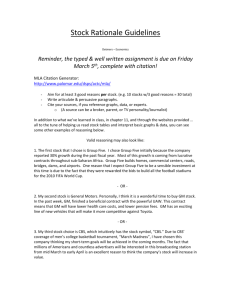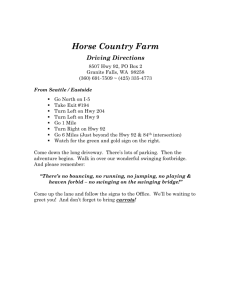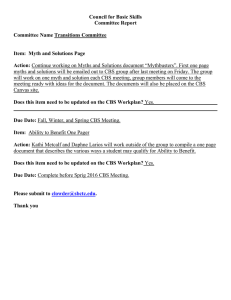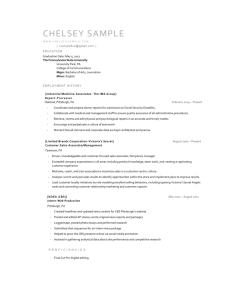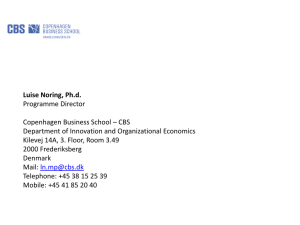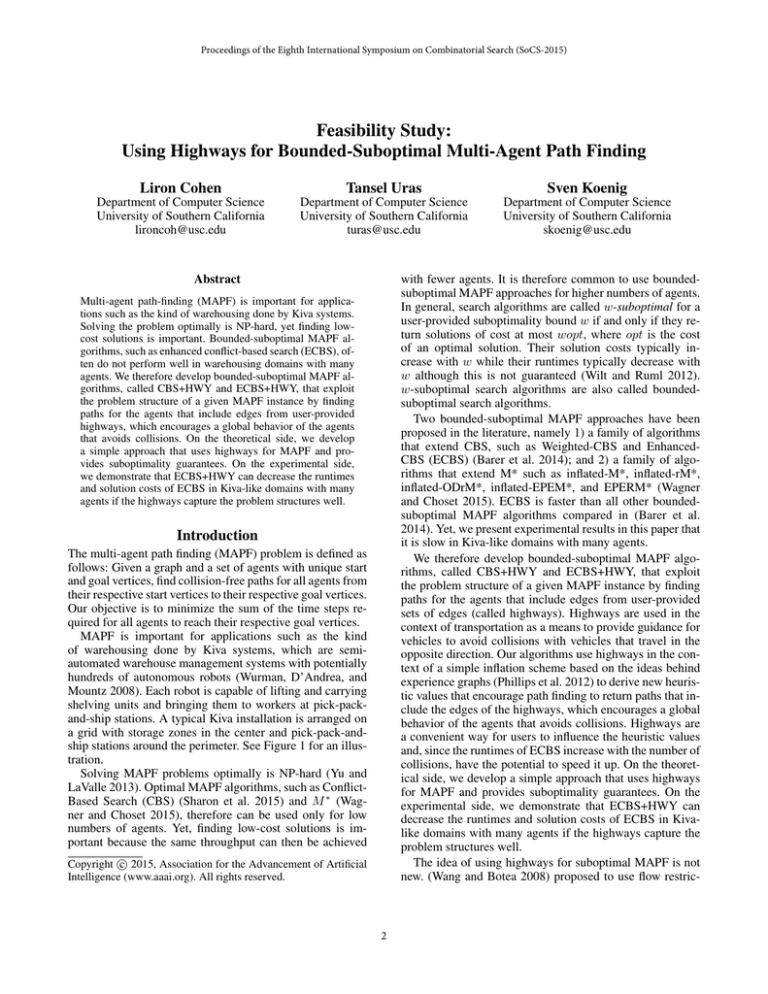
Proceedings of the Eighth International Symposium on Combinatorial Search (SoCS-2015)
Feasibility Study:
Using Highways for Bounded-Suboptimal Multi-Agent Path Finding
Liron Cohen
Tansel Uras
Sven Koenig
Department of Computer Science
University of Southern California
lironcoh@usc.edu
Department of Computer Science
University of Southern California
turas@usc.edu
Department of Computer Science
University of Southern California
skoenig@usc.edu
Abstract
with fewer agents. It is therefore common to use boundedsuboptimal MAPF approaches for higher numbers of agents.
In general, search algorithms are called w-suboptimal for a
user-provided suboptimality bound w if and only if they return solutions of cost at most wopt, where opt is the cost
of an optimal solution. Their solution costs typically increase with w while their runtimes typically decrease with
w although this is not guaranteed (Wilt and Ruml 2012).
w-suboptimal search algorithms are also called boundedsuboptimal search algorithms.
Two bounded-suboptimal MAPF approaches have been
proposed in the literature, namely 1) a family of algorithms
that extend CBS, such as Weighted-CBS and EnhancedCBS (ECBS) (Barer et al. 2014); and 2) a family of algorithms that extend M* such as inflated-M*, inflated-rM*,
inflated-ODrM*, inflated-EPEM*, and EPERM* (Wagner
and Choset 2015). ECBS is faster than all other boundedsuboptimal MAPF algorithms compared in (Barer et al.
2014). Yet, we present experimental results in this paper that
it is slow in Kiva-like domains with many agents.
We therefore develop bounded-suboptimal MAPF algorithms, called CBS+HWY and ECBS+HWY, that exploit
the problem structure of a given MAPF instance by finding
paths for the agents that include edges from user-provided
sets of edges (called highways). Highways are used in the
context of transportation as a means to provide guidance for
vehicles to avoid collisions with vehicles that travel in the
opposite direction. Our algorithms use highways in the context of a simple inflation scheme based on the ideas behind
experience graphs (Phillips et al. 2012) to derive new heuristic values that encourage path finding to return paths that include the edges of the highways, which encourages a global
behavior of the agents that avoids collisions. Highways are
a convenient way for users to influence the heuristic values
and, since the runtimes of ECBS increase with the number of
collisions, have the potential to speed it up. On the theoretical side, we develop a simple approach that uses highways
for MAPF and provides suboptimality guarantees. On the
experimental side, we demonstrate that ECBS+HWY can
decrease the runtimes and solution costs of ECBS in Kivalike domains with many agents if the highways capture the
problem structures well.
The idea of using highways for suboptimal MAPF is not
new. (Wang and Botea 2008) proposed to use flow restric-
Multi-agent path-finding (MAPF) is important for applications such as the kind of warehousing done by Kiva systems.
Solving the problem optimally is NP-hard, yet finding lowcost solutions is important. Bounded-suboptimal MAPF algorithms, such as enhanced conflict-based search (ECBS), often do not perform well in warehousing domains with many
agents. We therefore develop bounded-suboptimal MAPF algorithms, called CBS+HWY and ECBS+HWY, that exploit
the problem structure of a given MAPF instance by finding
paths for the agents that include edges from user-provided
highways, which encourages a global behavior of the agents
that avoids collisions. On the theoretical side, we develop
a simple approach that uses highways for MAPF and provides suboptimality guarantees. On the experimental side,
we demonstrate that ECBS+HWY can decrease the runtimes
and solution costs of ECBS in Kiva-like domains with many
agents if the highways capture the problem structures well.
Introduction
The multi-agent path finding (MAPF) problem is defined as
follows: Given a graph and a set of agents with unique start
and goal vertices, find collision-free paths for all agents from
their respective start vertices to their respective goal vertices.
Our objective is to minimize the sum of the time steps required for all agents to reach their respective goal vertices.
MAPF is important for applications such as the kind
of warehousing done by Kiva systems, which are semiautomated warehouse management systems with potentially
hundreds of autonomous robots (Wurman, D’Andrea, and
Mountz 2008). Each robot is capable of lifting and carrying
shelving units and bringing them to workers at pick-packand-ship stations. A typical Kiva installation is arranged on
a grid with storage zones in the center and pick-pack-andship stations around the perimeter. See Figure 1 for an illustration.
Solving MAPF problems optimally is NP-hard (Yu and
LaValle 2013). Optimal MAPF algorithms, such as ConflictBased Search (CBS) (Sharon et al. 2015) and M ∗ (Wagner and Choset 2015), therefore can be used only for low
numbers of agents. Yet, finding low-cost solutions is important because the same throughput can then be achieved
c 2015, Association for the Advancement of Artificial
Copyright Intelligence (www.aaai.org). All rights reserved.
2
has no constraints. The high-level search of CBS is a bestfirst search that uses the costs of the high-level nodes as fvalues. The cost of a high-level node is the sum of the path
costs of its paths. When CBS expands a high-level node N ,
it checks whether the node is a goal node. A high-level node
is a goal node if and only if none of its paths are in collision.
If N is a goal node, then CBS terminates successfully and
outputs the paths of the goal node as solution. Otherwise,
at least two paths are in collision, and CBS generates two
high-level children of N , called N1 and N2 . Both N1 and
N2 inherit the constraints of N . If the collision is a vertex
collision (j, k, s, t), then CBS adds the constraint (j, s, t)
to N1 and the constraint (k, s, t) to N2 . If the collision is
an edge collision (j, k, s1 , s2 , t), then CBS adds the constraint (j, s1 , s2 , t) to N1 and the constraint (k, s2 , s1 , t) to
N2 . When CBS generates a high-level node N , it performs a
low-level search for each agent independently. The low-level
search for agent j is a (best-first) A* search that ignores all
other agents and finds a minimum-cost path from agent j’s
start vertex to its goal vertex that is both feasible and respects
the constraints of N that involve agent j.
We use the following notation for all CBS variants: OPT
is the cost of an optimal solution of the MAPF instance.
OPTjN is the cost of an optimal path for agent j that respects the constraints of high-level node N . COSTjN is the
cost of the path found by the low-level search. Let OPTN =
PK
PK
j
j
j
j=1 OPTN and COSTN =
j=1 COSTN . LBN is the
minimum f -value in the OPEN list of the low-level search
for agent j after it terminates when high-level node N is genPK
erated. Let LBN = j=1 LBjN and LB = minN ∈OPEN LBN
for the OPEN list of the high-level search.
Figure 1: Typical Kiva domain (Wurman, D’Andrea, and Mountz 2008).
tion in road networks, such that movement along cells in the
grid is restricted to only one direction. Additional rules are
provided to ensure that no feasible path becomes infeasible.
Another approach was introduced by (Jansen and Sturtevant
2008) that uses direction maps, which represent joint information about how agents have been moving on the grid, and
leads to implicit cooperation during movement. However,
non of these approaches can guarantee bounded suboptimality.
Definitions
We define the MAPF problem formally as follows: We are
given a graph G = (V, E) and a set of K agents 1, . . . , K.
Each agent j has a unique start vertex sj ∈ V and a unique
goal vertex g j ∈ V . At each time step, each agent can either move to an adjacent vertex or wait at its current vertex,
both with cost one. A solution to a MAPF instance is a set
of feasible paths, one path {sj0 , . . . , sjTj , sjTj +1 , . . .} for each
agent j ∈ {1, . . . , K}, such that no two paths are in collision. A path for agent j is feasible if and only if 1) it starts at
agent j’s start vertex, that is, sj0 = sj ; 2) it ends at agent j’s
goal vertex and remains there, that is, there exists a lowest
Tj such that sjTj = g j and, for each t > Tj , sjt = g j ; and
3) every action is a legal move or wait action, that is, for all
t ∈ {0, 1, . . . , Tj − 1} , (sjt , sjt+1 ) ∈ E or sjt = sjt+1 . A collision between the paths of agents j and k is either a vertex
collision (j, k, s, t), that is, s = sjt = skt , or an edge collision
(j, k, s1 , s2 , t), that is, s1 = sjt = skt+1 and s2 = sjt+1 = skt .
A constraint is either a vertex constraint or an edge constraint. A vertex constraint (j, s, t) prohibits agent j from
occupying s at time step t. An edge constraint (j, s1 , s2 , t)
prohibits agent j from moving from s1 to s2 at time step t.
The cost of agent j’s path is the number of time steps Tj
until it reaches its goal vertex. Our objective is to minimize
PK
the sum j=1 Tj of the path costs of all agents, which is
a common objective in the literature (Yu and LaValle 2013;
Sharon et al. 2015).
ECBS
ECBS(w) (Barer et al. 2014) is a bounded-suboptimal
MAPF algorithm based on CBS that is faster than all
other bounded-suboptimal MAPF algorithms compared in
(Barer et al. 2014). The high-level and low-level searches of
ECBS(w) are focal searches (Pearl and Kim 1982) instead
of best-first searches. A best-first search maintains an OPEN
list. A focal search also maintains a FOCAL list, that contains a subset of the OPEN list. A best-first search expands
the node with the lowest f-value in the OPEN list. A focal
search, on the other hand, expands a node in the FOCAL list
that is determined by a user-provided tie-breaking criterion.
The low-level searches of ECBS(w) for agent j are focal
searches with a FOCAL list that contains all low-level nodes
n ∈ OPEN in the OPEN list of the low-level search such that
f (n) ≤ wfmin , where w > 1 is a user-provided parameter
and fmin is the lowest f-value of any node in the OPEN list.
We refer to a focal search with such a FOCAL list as regular
focal search. The high-level search of ECBS(w) is a focal
search with a FOCAL list that contains all high-level nodes
N ∈ OPEN in the OPEN list of the high-level search such
that COSTN ≤ wLB. The low-level searches and the highlevel search use their flexibility in deciding which nodes to
expand to reduce the number of collisions by using appropriate tie-breaking criteria. ECBS(w) is w-suboptimal if its
low-level searches are allowed to re-expand nodes to lower
CBS
CBS (Sharon et al. 2015) is an optimal MAPF algorithm.
It performs high-level and low-level searches. Each node in
the high-level search tree (high-level node) contains a set of
constraints and a set of feasible paths (one for each agent)
that respect the set of constraints. The high-level root node
3
where π = {s, . . . , g j } is a feasible path that takes agent j
from s to its goal vertex. We can easily adapt the highway
heuristic values to graphs with non-uniform edge costs.
Proposition 1. For all agents j and states s, hj (s) ≤
hjhwy (s) ≤ whj (s).
the f-values of the nodes.
Incorporating Highways
The low-level searches of all CBS variants when high-level
node N is generated typically use the shortest-path heuristic
values hj (s), that is, the perfect heuristic values for agent j
when all constraints of N are ignored, defined formally as
X
j
h (s) = min
π
Heuristic values h(s) are w-admissible if and only if 0 ≤
h(s) ≤ wopt(s) for each state s, where opt(s) is the cost
of an optimal solution for start vertex s. Thus, the heuristic
values hjhwy (s) are w-admissible according to Proposition 1
since the shortest-path heuristic values are admissible.
Figure 2(a) shows a MAPF instance as an example. The
shortest-path heuristic values for agents 1 and 2 are shown
in (c) and (d), respectively. The highway heuristic values
for agents 1 and 2 are shown in (e) and (f), respectively,
for w = 2 and the highway shown in (b). For instance, the
shortest-path heuristic value for agent 1 and the cell in row 2
and column 3 is 2 (corresponding to moving east and south,
each with cost one) while the highway heuristic value is 3
(corresponding to moving east with cost two and then following the highway south with cost one).
1,
(si ,si+1 )∈π
where π = {s, . . . , g j } is a feasible path that takes agent
j from s to its goal vertex. The shortest-path heuristic values can be computed quickly and are more informed than
the Manhattan distance heuristic values, which is why CBS
variants use them to guide their low-level searches. The lowlevel searches of Weighted-CBS and M* for agent j are
weighted A* searches with whj (s) as heuristic values, that
is, the heuristic values hj (s) are inflated uniformly by w.
The low-level searches of ECBS(w) for agent j are regular focal searches with a FOCAL list that contains all nodes
n ∈ OPEN in the OPEN list of the low-level search such that
f (n) = g(n) + hj (n) ≤ wfmin , where fmin is the lowest
f-value of any node in the OPEN list.
Increasing w allows for longer paths, which provides
agents with the flexibility to avoid collisions by moving
around other agents in domains with few agents. The highlevel searches of CBS variants then have to resolve fewer
collisions and can terminate earlier, potentially reducing the
runtimes of the CBS variants. However, this also makes
the agents spread out more, which can in turn result in
a higher number of additional collisions in domains with
many agents and increase the runtimes of the CBS variants.
Thus, larger values of w are not necessarily beneficial.
We therefore develop bounded-suboptimal MAPF algorithms that exploit the problem structure of a given MAPF
instance by finding paths for the agents that include edges
from user-provided sets of edges (called highways). Highways are used in the context of transportation as a means
to provide guidance for vehicles to avoid collisions with vehicles that travel in the opposite direction. Our algorithms
inflate heuristic values non-uniformly in a way that encourages path finding to return paths that include the edges of the
highways, which encourages a global behavior of the agents
that avoids collisions. Highways are a convenient way for
users to influence the heuristic values and, since the runtimes
of CBS variants increase with the number of collisions, have
the potential to speed them up. We use the ideas behind experience graphs (Phillips et al. 2012), which were developed
to speed up motion planning, to derive suitable heuristic values.
Formally, a highway is a subgraph Ghwy = (Vhwy , Ehwy )
of the given graph G = (V, E). The low-level searches use
the highway heuristic values hjhwy (s) for the user-provided
parameter w > 1 (that determines the level of encouragement for path finding to return paths that include the edges
of the highway), defined formally as
hjhwy (s)
= min
X
π
1
w
Collision-Based Search with Highways
Our first bounded-suboptimal MAPF algorithm, called
CBS+HWY(w), is a version of CBS whose low-level
searches use the highway heuristic values with parameter w
instead of the shortest-path heuristic values.
Theorem 2. CBS+HWY(w) is w-suboptimal.
Proof. Let M be any high-level node in the OPEN list of the
high-level search of CBS+HWY(w) that contains an optimal solution of the MAPF instance (that is, OPTM = OPT).
Such an M exists according to Lemma 2 of (Sharon et al.
2015). The low-level searches of CBS+HWY(w) use wadmissible heuristic values according to Lemma 1. The lowlevel search for agent j when high-level node M is generated
thus is guaranteed to find a path with cost at most wOPTjM ,
that is, COSTjM ≤ wOPTjM . The proof is identical to the
one that proves the suboptimality guarantee of Weighted-A*
(Pohl 1970). Consequently, COSTM ≤ wOPTM = wOPT.
The high-level search of CBS+HWY(w) is a best-first search
and can thus never expand a high-level goal node with
a cost of more than wOPT. Thus, CBS+HWY(w) is wsuboptimal.
w
HL-Exp
HL-Gen
LL-Exp
LL-Gen
SolCost
CBS
7
13
70
277
9
CBS+HWY(w)
1.1 1.2 1.5 2.0
7
7
3
1
13
13
5
1
70
70
30
12
277 277 115 31
9
9
9
12
1.1
7
13
70
277
9
ECBS(w)
1.2 1.5
3
1
5
1
30
9
115 33
9
9
2.0
1
1
9
33
9
Table 1: Expanded and generated nodes and solution costs for CBS, CBS+HWY(w),
and ECBS(w) for the example in Figure 2.
Figures 2(g) and (h) show the paths found by CBS
and CBS+HWY(2.0), respectively, for the example in Figure 2(a). The value of w = 2.0 is high enough to
if (si , si+1 ) ∈ Ehwy
otherwise,
(si ,si+1 )∈π
4
s2
s1
g1
g2
(a)
5
4
3
2
5
4
3
4
5
4
3
2
7
6
5
4
4
3
2
1
4
3
2
3
6
5
3
1
8
6
4
3
3
2
1
0
3
2
1
2
6
4
2
0
6
4
2
2
4
3
2
1
2
1
0
1
7
6
4
2
4
2
0
1
(b)
(c)
(d)
(e)
(f)
(g)
(h)
Figure 2: Differences between CBS and CBS+HWY(2.0) in a pathological domain where CBS is extremely inefficient. (a) shows the start and goal vertices for the two agents. (b)
shows the highway. (c) and (d) show the shortest-path heuristic values for agents 1 and 2, respectively. (e) and (f) show the highway heuristic values for agents 1 and 2, respectively.
(g) shows the paths found by CBS. (h) shows the paths found by CBS+HWY(2.0). Each dot represent a time step. Two dots in the same cell thus represent a wait action.
make both agents travel along the outer ring to their respective goal vertices. We ran CBS and, for each w ∈
{1.1, 1.2, 1.5, 2.0}, CBS+HWY(w) and ECBS(w) on the
example in Figure 2. We ran all experiments on a computer with a 3.2GHz Intel Core i7 CPU and 8GBytes of
RAM. Table 1 shows the number of expanded and generated nodes by the high-level and low-level searches (HLExp, LL-Exp, HL-Gen, and LL-Gen, respectively) and the
solution costs (SolCost). The paths found by the low-level
searches of CBS+HWY(2.0) avoid the inevitable collision
of the optimal paths of the two agents when there are no
constraints, which explains why CBS+HWY(2.0) expands
fewer nodes than CBS although it has a higher solution
cost. However, comparing a bounded-suboptimal MAPF algorithm, like CBS+HWY(2.0), with an optimal one, like
CBS, is like comparing apples and oranges. Comparing two
bounded-suboptimal MAPF algorithms with the same suboptimality bound, like CBS+HWY(2.0) and ECBS(2.0), is
fairer. Unfortunately, ECBS(2.0) expands fewer nodes than
CBS+HWY(2.0) and finds a solution of lower cost. However, the example is too simple. The number of agents is
low, and a single wait action by one of the two agents prevents the collision of their paths.
w
HL-Exp
HL-Gen
LL-Exp
LL-Gen
Runtime
SolCost
CBS+HWY(w)
1.5
2.0
8071
27
16,119
47
992,260
3,754
2,623,514 10,212
51,293
266
440
423
and the solution costs. CBS+HWY(1.1), CBS+HWY(1.2),
ECBS(1.1), and ECBS(1.2) fail to find any solutions within
the five-minute runtime limit and are thus omitted from
the table. ECBS(2.0) can find longer paths than ECBS(1.5)
which provides agents with the flexibility to avoid collisions
by moving around other agents, resulting in them spreading out more, which in turn results in a higher number of
additional collisions since many agents traverse the narrow corridor in both directions. This property could explain
why ECBS(2.0) expands more nodes than ECBS(1.5), has
a higher runtime and finds a solution of higher cost. On
the other hand, the highway directs agents moving from
east to west to stay north in the corridor and agents moving from west to east to stay south in the corridor, which
avoids many collisions. This property could explain why
CBS+HWY(w) finds a solution of lower cost than ECBS(w)
for both w = 1.5 and w = 2.0. It has a higher runtime for
w = 1.5 but a lower runtime for w = 2.0.
Enhanced Collision-Based Search with Highways
The example in Figure 2 demonstrates the advantage of
ECBS(w), whose strength seems to be in reducing vertex collisions. On the other hand, the example in Figure 3
demonstrates the advantage of using highways in the context of CBS+HW(w), whose strength seems to be in reducing edge collisions. Both MAPF algorithms provide suboptimality guarantees. It thus makes sense to try to combine them to develop a bounded-suboptimal MAPF algorithm whose strength is in reducing both vertex and edge
collisions. Our second bounded-suboptimal MAPF algorithm, called ECBS(w1 )+HWY(w2 ), is therefore a version
of ECBS(w1 ) whose low-level searches use the highway
heuristic values with parameter w2 instead of the shortestpath heuristic values. The following lemma asserts that
the low-level searches of ECBS(w1 )+HWY(w2 ) are w1 w2 suboptimal and that LBjN ≤ w2 OPTjN for all high-level
nodes N and agents j.
ECBS(w)
1.5
2.0
33
67
37
88
10,979 63,486
19,567 87,229
468
3,073
460
521
Table 2: Expanded and generated nodes, runtimes (in milliseconds) and solution costs
for CBS+HWY(w) and ECBS(w) for the example in Figure 3.
We therefore also ran, for each w ∈ {1.1, 1.2, 1.5, 2.0},
CBS+HWY(w) and ECBS(w) on the example in Figure 3,
which is a more complex MAPF instance with a problem
structure that highways can exploit. Blocked cells in the grid
of size 5 × 20 are shown in black. There is open space of
size 5 × 5 on both sides, connected by a corridor of width
two. 10 agents have their start vertices in the left open space
and their goal vertices in the right open space, and 10 agents
have their start vertices in the right open space and their goal
vertices in the left open space. The arrows show the highway. Table 2 shows the number of expanded and generated
nodes by the high-level and low-level searches, the runtimes,
Lemma 3. A regular focal search with parameter w1 > 1
that uses the f-values f (n) = g(n) + w2 h(n) for admissible heuristic values h(n) and parameter w2 > 1 is w1 w2 suboptimal. Furthermore, the minimum f-value in its OPEN
list is always at most w2 times the cost of an optimal solution.
Proof. We consider two focal searches: First, we consider
regular focal search Search1 with parameter w1 that uses the
5
s19 , g 9 s18 , g 8 s15 , g 5 s13 , g 3 s11 , g 1
s9 , g 19 s8 , g 18 s5 , g 15 s3 , g 13 s1 , g 11
s20 , g 10 s17 , g 7 s16 , g 6 s14 , g 4 s12 , g 2
s10 , g 20 s7 , g 17 s6 , g 16 s4 , g 14 s2 , g 12
Figure 3: Corridor example on which we compare CBS+HWY(w) and ECBS(w).
f-values f (n) = g(n) + w2 h(n), as used in the lemma. Its
FOCAL list thus is
Theorem 4. ECBS(w1 )+HWY(w2 ) is w1 w2 -suboptimal.
Proof. Let M be any high-level node in the OPEN list of
the high-level search of ECBS(w1 )+HWY(w2 ) that contains
an optimal solution of the MAPF instance (that is, OPTM =
OPT). Such an M exists analogously to Lemma 2 of (Sharon
et al. 2015). Then,
FOCAL1 = {n ∈ OPEN :
g(n) + w2 h(n) ≤ w1 (g(n1min ) + w2 h(n1min ))},
where n1min = arg minn∈OPEN (g(n) + w2 h(n)). Second, we
consider regular focal search Search2 with parameter w1 w2
that uses the f-values f (n) = g(n) + h(n). Its FOCAL list
thus is
LB ≤ LBM =
K
X
LBjM
j=1
FOCAL2 = {n ∈ OPEN :
g(n) + h(n) ≤ w1 w2 (g(n2min ) + h(n2min ))},
≤
K
X
w2 OPTjM
j=1
where n2min = arg minn∈OPEN (g(n) + h(n)). Both focal
searches are allowed to re-expand nodes to lower the fvalues of the nodes.
We show by induction that the OPEN lists of both
searches can always be the same. Initially, both OPEN lists
contain only the start node and thus are the same. Assume
that they are the same at some point in time. Then, for each
node n ∈ FOCAL1 , it holds that
= w2 OPTM
= w2 OPT
since LBjM ≤ w2 OPTjM according to Lemma 3. The highlevel search of ECBS(w1 )+HWY(w2 ) is a focal search with
a FOCAL list that contains all nodes N ∈ OPEN such that
COSTN ≤ w1 LB. Thus, it always expands a node whose
cost is at most w1 LB ≤ w1 w2 OPT. Consequently, the highlevel search can never expand a high-level goal node with a
cost of more than w1 w2 OPT, and ECBS(w1 )+HWY(w2 ) is
w1 w2 -suboptimal.
g(n) + h(n) ≤ g(n) + w2 h(n)
≤ w1 (g(n1min ) + w2 h(n1min ))
≤ w1 (g(n2min ) + w2 h(n2min ))
≤ w1 (w2 g(n2min ) + w2 h(n2min ))
Experimental Results
≤ w1 w2 (g(n2min ) + h(n2min )).
We evaluated ECBS(w) and ECBS(w1 )+HWY(w2 ) in a
Kiva-like domain, see Figure 4. Blocked cells in the grid of
size 22 × 54 are shown in black, and all corridors between
them are of width one. There are open spaces of size 22 × 5
on both sides, called Area1 and Area2. We randomly generated 10 instances with 150 agents. We simulated robots
carrying shelving units from one side of the warehouse to
a pick-pack-and-ship station on the other side of the warehouse. 75 agents thus have randomly chosen start vertices
from Area1 and randomly chosen goal vertices from Area2,
while the other 75 agents have randomly chosen start vertices from Area2 and randomly chosen goal vertices from
Area1.
We ran, for each w ∈ {1.1, 1.2, 1.5, 2.0}, ECBS(w) on
each of the 10 instances. Table 3 shows the runtimes and
solution costs. ECBS(1.5) solves 4 of the 10 instances.
ECBS(1.1), ECBS(1.2), and ECBS(2.0) fail to find any solutions within the five-minute runtime limit and are thus omitted from the table, showing that higher values of w are not
necessarily beneficial, as argued earlier.
Therefore, n ∈ FOCAL2 and, consequently, FOCAL1 ⊆
FOCAL2 . Thus, if Search1 expands n, Search2 can be
forced to expand n as well and their OPEN lists are then
again the same. Thus, they eventually find the same solution.
It is known that Search 2 is w1 w2 -suboptimal. Thus, Search1
is w1 w2 -suboptimal as well. Furthermore, it is known that
the minimum f-value in the OPEN list of Search2 is always
at most the cost of the optimal solution opt. Then, since the
OPEN lists of both searches are always the same, it always
holds that
min (g(n) + h(n)) ≤ opt
n∈OPEN
w2 min (g(n) + h(n)) ≤ w2 opt
n∈OPEN
min (w2 g(n) + w2 h(n)) ≤ w2 opt
n∈OPEN
min (g(n) + w2 h(n)) ≤ w2 opt.
n∈OPEN
Thus, the minimum f-value in the OPEN list of Search1 is
always at most w2 times the cost of the optimal solution.
6
SolCost
10,258
10,530
253,564
10,246
261,067
10,310
ECBS(w1 )+HWY(2.0)
w1 = 1.2
Runtime SolCost
9,625
103,600
9,660
9,736
183,379
10,041
204,533
179,214
9,892
146,298
9,619
9,880
9,494
9,476
9,834
136,049
9,449
9,590
83,679
9,865
118,998
10,085
201,038
w1 = 1.1
Runtime SolCost
191,211
209,197
210,227
206,498
291,254
w1 = 1.5
Runtime SolCost
10,588
223,159
10,603
260,522
268,431
294,717
261,957
10,577
10,396
10,272
277,931
239,336
10,313
10,639
Table 3: Runtimes (in milliseconds) and solution costs for ECBS(1.5) and
ECBS(w1 )+HWY(2.0) for the example in Figure 4. Cells are empty if an algorithm
did not terminate within a five-minute runtime limit.
Figure 4: Kiva-like domain
ECBS(w1 )+HWY(2.0).
We ran, for each w1
∈
{1.1, 1.2, 1.5, 2.0},
ECBS(w1 )+HWY(2.0) on each of the 10 instances. The
arrows in Figure 4 show the highway. Again, Table 3 shows
the runtimes and solution costs. ECBS(2.0)+HWY(2.0)
fails to find any solutions within the five-minute runtime
limit and is thus omitted from the table, showing again
that higher values of w1 are not necessarily beneficial.
ECBS(w1 )+HWY(w2 ) often has lower runtimes or solution
costs or solves more instances than ECBS(w), which is
encouraging despite being anecdotal.
We experimented with different highway layouts and
parameters w1 and w2 for ECBS(w1 )+HWY(w2 ) but no
combination dominates all others. However, these parameters are clearly important factors for the performance
of ECBS(w1 )+HWY(w2 ): First, we ran, for each w2 ∈
{1.2, 1.5, 2.0, 3.0}, ECBS(1.5)+HWY(w2 ) on each of the
10 instances of the example in Figure 4 after reducing the
highway to the outer ring (that is, the top-most, right-most,
bottom-most and left-most arrows). The level of encouragement for path finding to return paths that include the edges
of the highways and thus the solution costs increase with
w2 because the agents then tend to use the highway to circumnavigate the center rather than cut through it. Second,
if the highways do not capture the problem structures well
and thus do not help to reduce collisions among the paths,
then ECBS(w1 )+HWY(w2 ) not only does not improve over
ECBS(w) but can have higher runtimes or solution costs or
solve fewer instances.
Instance
1
2
3
4
5
6
7
8
9
10
266,169
10,840
ECBS(1.5)+HWY ring(w)
w=1.5
w=2
RunTime SolCost RunTime SolCost
11,059
177,171
11,098
258,463
10,856
11,161
244,781
175,048
11,631
241,583
11,239
11,152
265,795
186,265
11,308
11,133
294,468
247,199
252,721
10,595
251,333
11,150
269,460
11,115
w=1.2
RunTime SolCost
10,653
253,923
11,067
197,154
202,411
11,447
on
which
we
compare
ECBS(w)
and
150 agents inside Area1 and Area2. In those areas, CBS has
less flexibility than ECBS(w) to avoid collisions by moving
agents around other agents, which could explain why it fails
to find solutions within the runtime limit.
Conclusions
We presented a new bounded-suboptimal MAPF approach
that takes advantage of additional inputs that represent a
highway and a parameter w. It uses the highway to derive new w-admissible heuristic values that encourage path
finding to return paths that include the edges of the highway. The level of encouragement increases with w. Our
new bounded-suboptimal variants of CBS and ECBS(w),
called CBS+HWY(w) and ECBS(w1 )+HWY(w2 ), encourage a global behavior of the agents that avoids collisions.
On the theoretical side, we developed a simple approach
that uses highways for MAPF and provides suboptimality
guarantees. On the experimental side, we demonstrated that
ECBS(w1 )+HWY(w2 ) can decrease the runtimes and solution costs of ECBS(w) in Kiva-like domains with many
agents if the highway captures the problem structure well.
In future work, we plan to develop approaches that determine good highways automatically, investigate whether
inflating the edge costs of the given graph (by increasing
the costs of highway edges to w) in addition to inflating
the heuristic values provides additional benefits, figure out
whether penalizing movement costs against highway edges
(similar to direction maps (Jansen and Sturtevant 2008))
helps to improve the performance of our MAPF approaches
while continuing to provide suboptimality guarantees, extend ECBS(w1 )+HWY(w2 ) to split the user-provided suboptimality bound w dynamically between w1 and w2 (similar to how ECBS(w) splits the suboptimality bound w dynamically between the high-level and low-level searches),
and explore highways in the context of other MAPF algorithms, such as M* and inflated M*.
w=3
RunTime SolCost
11,354
276,075
11,707
240,897
11,414
271,442
11,319
172,725
11,363
200,102
294,624
Area2
1
2
3
4
5
6
7
8
9
10
ECBS(1.5)
Runtime
272,440
267,807
Area1
Instance
11,245
Table 4: Runtimes (in milliseconds) and solution costs for ECBS(1.5)+HWY(w2 ) for
the example in Figure 4, where the highway consists of the outer ring only. Cells are
empty if an algorithm did not terminate within a five-minute runtime limit.
Acknowledgments
We thank Maxim Likhachev and Michael Phillips for helpful discussions. We also thank Ariel Felner, Guni Sharon,
and Maxim Barer for their CBS and ECBS(w) source code,
which we used in our experiments. Our research was supported by NSF under grant numbers 1409987 and 1319966.
The views and conclusions contained in this document are
We also ran CBS+HWY(w) but it fails to terminate
within the five-minute runtime limit on all Kiva-like instances regardless of the highway layout. While the highways provide good guidance to move agents in the corridors, CBS+HWY(w) still has to find collision-free paths for
7
those of the authors and should not be interpreted as representing the official policies, either expressed or implied, of
the sponsoring organizations, agencies or the U.S. government.
References
Barer, M.; Sharon, G.; Stern, R.; and Felner, A. 2014. Suboptimal variants of the conflict-based search algorithm for
the multi-agent pathfinding problem. In Proceedings of the
7th Annual Symposium on Combinatorial Search (SOCS).
Jansen, M., and Sturtevant, N. 2008. Direction maps for
cooperative pathfinding. In Proceedings of the 4th Artificial
Intelligence and Interactive Digital Entertainment Conference (AIIDE), 185–190.
Pearl, J., and Kim, J. H. 1982. Studies in semi-admissible
heuristics. IEEE Transactions on Pattern Analysis and Machine Intelligence 4:392 –399.
Phillips, M.; Cohen, B. J.; Chitta, S.; and Likhachev, M.
2012. E-graphs: Bootstrapping planning with experience
graphs. In Proceedings of the 8th Robotics: Science and
Systems Conference (RSS).
Pohl, I. 1970. Heuristic search viewed as path finding in a
graph. Artificial Intelligence 1(3):193–204.
Sharon, G.; Stern, R.; Felner, A.; and Sturtevant, N. R. 2015.
Conflict-based search for optimal multi-agent pathfinding.
Artificial Intelligence 219:40–66.
Wagner, G., and Choset, H. 2015. Subdimensional expansion for multirobot path planning. Artificial Intelligence
219:1–24.
Wang, K.-H. C., and Botea, A. 2008. Fast and MemoryEfficient Multi-Agent Pathfinding. In Proceedings of the
18th International Conference on Automated Planning and
Scheduling (ICAPS), 380–387.
Wilt, C. M., and Ruml, W. 2012. When does weighted A*
fail? In Proceedings of the 5th Annual Symposium on Combinatorial Search (SOCS).
Wurman, P. R.; D’Andrea, R.; and Mountz, M. 2008. Coordinating hundreds of cooperative, autonomous vehicles in
warehouses. AI Magazine 29(1):9–20.
Yu, J., and LaValle, S. M. 2013. Structure and intractability
of optimal multi-robot path planning on graphs. In Proceedings of the 27th AAAI Conference on Artificial Intelligence
(AAAI).
8


